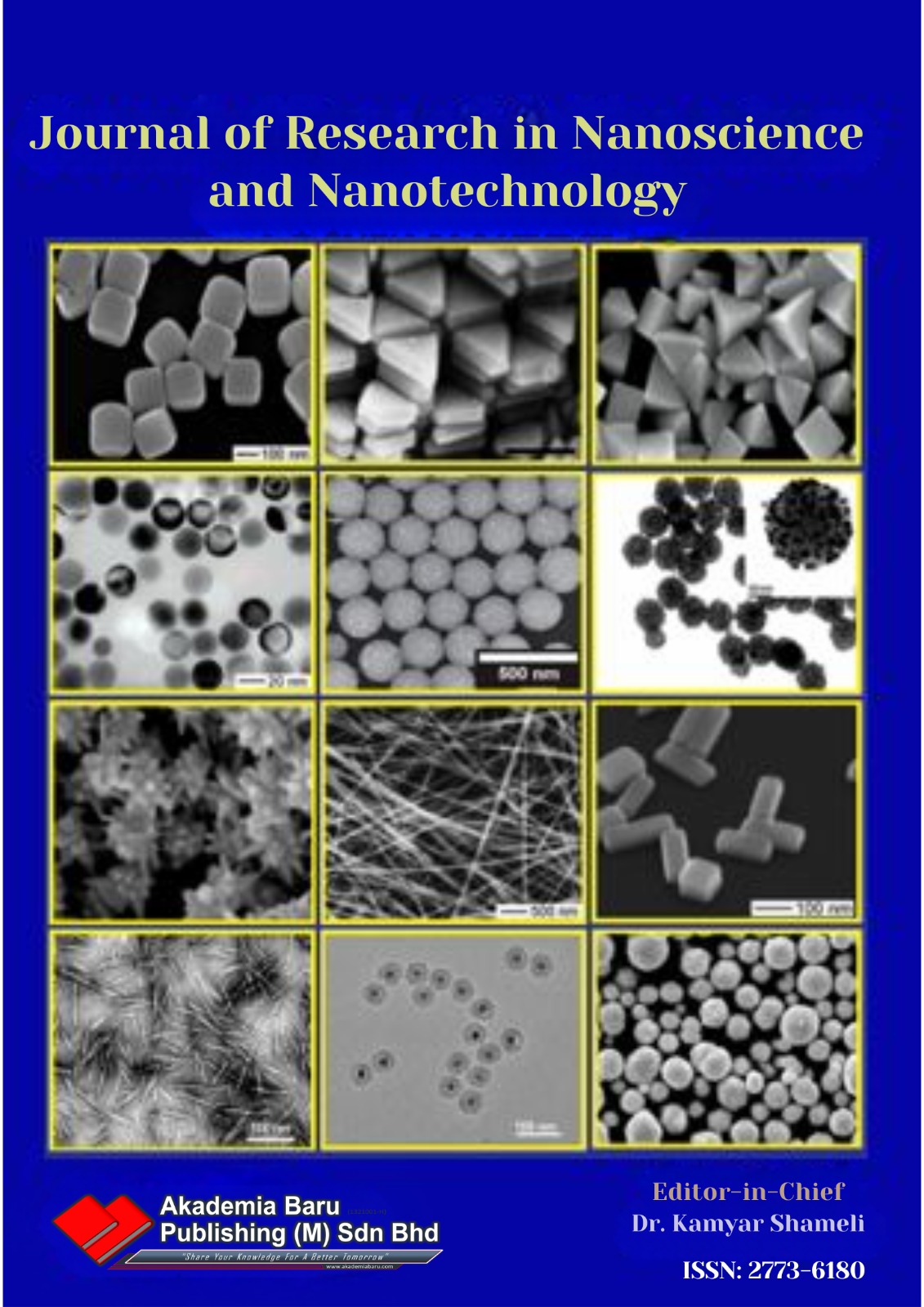Physiochemical Synthesis of Silver/Kaolinite Nanocomposites and Study their Antibacterial Properties
DOI:
https://doi.org/10.37934/jrnn.1.1.111Keywords:
Silver nanoparticles, kaolinite, Gamma irradiation, Chemical synthesis, Gram positive, Negative bacteriaAbstract
Silver nanocomposites (Ag NCs) were prepared by two methods, chemical and physical synthesis using sodium borohydride and gamma irradiation as a reducing tool. A one-step silver/kaolinite nanocomposite (Ag/Kln NCs) synthesis method has been developed successfully by irradiation technique at room temperature and under ambient pressure. The Ag/Kln NCs produced by the ?-irradiation technique is pure without chemical residues, has a good distribution with enhanced antibacterial properties, and environmentally friendly. The effects of various experimental parameters on the formation of NCs, such as the concentration of Ag+ and the irradiation dose, have been investigated. A study on antimicrobial susceptibility was undertaken to determine the antibacterial properties of Ag NCs in the presence of gram-positive and gram-negative bacteria. The susceptibility of the microorganisms to varying concentrations of Ag NCs synthesized via physical synthesis using gamma irradiation was compared to those synthesized chemically. Concentrations of Ag NCs used were 0.5, 1.0, 2.0, 5.0, and 10 % for chemical synthesis and irradiation doses used for physical synthesis were 7, 13, 20, 30, 40, 50, 65 and 80 kGy. Observation on well diffusion variant showed a significantly large zone of inhibition for physically synthesized NCs, (63 to 107% relative to control) which indicates high antimicrobial activity. Chemically synthesized NCs using the same experimental set up however showed a significantly smaller zone of inhibition. The Ag/Kln NCs in 20kGy showed higher antibacterial activity against Enterococcus faecalis and Escherichia coli as gram-positive and gram-negative bacteria. These suggest that Ag/Kln NCs can be employed as an effective bacteria inhibitor and can be applied in the medical field.
Downloads
References
I. Khan, K. Saeed, and I. Khan, “Nanoparticles: Properties, applications and toxicities,” Arab. J. Chem., vol. 12, no. 7, pp. 908–931, 2019, doi: 10.1016/j.arabjc.2017.05.011.
S. Hasan, “A Review on Nanoparticles?: Their Synthesis and Types,” Res. J. Recent Sci. Res . J . Recent . Sci . Uttar Pradesh ( Lucknow Campus ), vol. 4, no. March, pp. 1–3, 2014, doi: 10.3233/978-1-61499-057-4-57.
M. Akter et al., “A systematic review on silver nanoparticles-induced cytotoxicity: Physicochemical properties and perspectives,” J. Adv. Res., vol. 9, pp. 1–16, 2018, doi: 10.1016/j.jare.2017.10.008.
U. Latif, K. Al-Rubeaan, and A. T. M. Saeb, “A Review on Antimicrobial Chitosan-Silver Nanocomposites: A Roadmap Toward Pathogen Targeted Synthesis,” Int. J. Polym. Mater. Polym. Biomater., vol. 64, no. 9, pp. 448–458, 2015, doi: 10.1080/00914037.2014.958834.
F. A. Qais et al., “Antibacterial Effect of Silver Nanoparticles Synthesized Using Murraya koenigii ( L .) against Multidrug-Resistant Pathogens,” vol. 2019, 2019.
S. Zhang, Y. Tang, and B. Vlahovic, “A Review on Preparation and Applications of Silver-Containing Nanofibers,” Nanoscale Res. Lett., vol. 11, no. 1, pp. 1–8, 2016, doi: 10.1186/s11671-016-1286-z.
S. J. Nurani, K. C. Saha, M. A. Rahman Khan, and S. M. H. Sunny, “Silver Nanoparticles Synthesis, Properties, Applications and Future Perspectives: A Short Review,” IOSR J. Electr. Electron. Eng. Ver. I, vol. 10, no. 6, pp. 117–126, 2015, doi: 10.9790/1676-1061117126.
G. Vanitha, K. Rajavel, G. Boopathy, V. Veeravazhuthi, and P. Neelamegam, “Physiochemical charge stabilization of silver nanoparticles and its antibacterial applications,” Chem. Phys. Lett., vol. 669, no. 3, pp. 71–79, 2017, doi: 10.1016/j.cplett.2016.11.037.
K. Zheng, M. I. Setyawati, D. T. Leong, and J. Xie, “Antimicrobial silver nanomaterials,” Coord. Chem. Rev., vol. 357, pp. 1–17, 2018, doi: 10.1016/j.ccr.2017.11.019.
B. D. Altinsoy, G. ?eker Karatoprak, and I. Ocsoy, “Extracellular directed ag NPs formation and investigation of their antimicrobial and cytotoxic properties,” Saudi Pharm. J., vol. 27, no. 1, pp. 9–16, 2019, doi: 10.1016/j.jsps.2018.07.013.
B. Le Ouay and F. Stellacci, “Antibacterial activity of silver nanoparticles: A surface science insight,” Nano Today, vol. 10, no. 3, pp. 339–354, 2015, doi: 10.1016/j.nantod.2015.04.002.
S. K. Balavandy, K. Shameli, and Z. Z. Abidin, "Rapid and green synthesis of silver nanoparticles via sodium alginate madia", Int. J. Electrochem. Sci., vol. 10, pp. 486-497, 2015.
M. Ahmad, K. Shameli, and M. Zargar, "Synthesis and antibacterial activity of silver/montmorillonite nanocomposites", Res. J. Biol. Sci., vol. 4, no. 9, pp. 1032-1036, 2009.
K. Shameli, M. Ahmad, E. A. J. Al-Mulla, and P. Shabanzadeh, "Antibacterial effect of silver nanoparticles on talc composites", Res. Chem. Intermed., vol. 41, no. 1, pp. 251-263, 2015, doi: 10.1007/s111640131188y.
K. Shameli, M. Ahmad, and M. Jokar, "Synthesis and characterization of silver/polylactide nanocomposites", World Acad Sci. Eng. Technol., vol. 40, no. 2010, pp. 28-32, 2010.
P. Shabanzadeh, R. Yusof, and K. Shameli, "Artificial neural network for modeling the size of silver nanoparticles’ prepared in montmorillonite/starch bionanocomposites", J. Ind. Eng. Chem., vol. 24, pp. 42-50, 2015, doi: org/10.1016/j.jiec.2014.09.007.
N. I. S. Abdullah, M. Ahmad, and K. Shameli, "Biosynthesis of silver nanoparticles using Artocarpus elasticus stem bark extract". Chem. Cent. J., vol. 9, no. 61, pp. 1-7, 2015, doi: 10.1186/s1306501501330.
B. D. Altinsoy, G. ?eker Karatoprak, and I. Ocsoy, “Extracellular directed ag NPs formation and investigation of their antimicrobial and cytotoxic properties,” Saudi Pharm. J., vol. 27, no. 1, pp. 9–16, 2019, doi: 10.1016/j.jsps.2018.07.013.
M. J. Khan, K. Shameli, A. Q. Sazili, J. Selamat, and S. Kumari, "Rapid green synthesis and characterization of silver nanoparticles arbitrated by curcumin in an alkaline medium", Molecules, vol. 24, no. 719, pp. 1-12, 2019, doi: 10.3390/molecules24040719.
M. Ahmad, K. Shameli, and M. Zargar, "Antibacterial activity of silver/clay/chitosan bionanocomposites", Res. J. Biol. Sci., vol. 4, no.11, pp. 1156-1161, 2009, ISSN: 1815-8846.
B. D. Altinsoy, G. ?eker Karatoprak, and I. Ocsoy, “Extracellular directed ag NPs formation and investigation of their antimicrobial and cytotoxic properties,” Saudi Pharm. J., vol. 27, no. 1, pp. 9–16, 2019, doi: 10.1016/j.jsps.2018.07.013.
B. Le Ouay and F. Stellacci, “Antibacterial activity of silver nanoparticles: A surface science insight,” Nano Today, vol. 10, no. 3, pp. 339–354, 2015, doi: 10.1016/j.nantod.2015.04.002.
J. Natsuki, T. Natsuki, and Y. Hashimoto, “A Review of Silver Nanoparticles: Synthesis Methods, Properties and Applications,” Int. J. Mater. Sci. Appl., vol. 4, no. 5, pp. 325-332, 2015, doi: 10.11648/j.ijmsa.20150405.17.
M. Faried, K. Shameli, M. Miyake, A. Hajalilou, K. Kalantari, Z. Zakaria, H. Hara, N. B. A. Khairudin, "Synthesis of silver nanoparticles via green method using ultrasound irradiation in seaweed Kappaphycus alvarezii media", Res. Chem. Intermed., vol. 42, pp. 7991–8004, 2016, doi: 10.1007/s111640162574z.
R. F. Elsupikhe, K. Shameli, and M. Ahmad, "Sonochemical method for the synthesis of silver nanoparticles in ?-carrageenan from silver salt at different concentrations", Res. Chem. Intermed., vol. 41, pp. 8515–8525, 2015, doi: 10.1007/s111640141907z.
M.S.N. Salleh, R.Rasit Ali, K. Shameli, M.Y. Hamzah, and J.Z. Chan, "Silver nanoparticles on pullulan derived via gamma irradiation method: A preliminary analysis", IOP Conf. Ser., Mater. Sci. Eng., vol. 808, no. 012030, pp. 1-8, doi:10.1088/1757-899X/808/1/012030.
K. Shameli, M. Ahmad, W. M. Z. W. Yunus, A. Rustaiyan, and M. Zargar, "Green synthesis of silver/montmorillonite/chitosan bionanocomposites using the UV-irradiation method and evaluation of antibacterial activity", Int. J. Nanomedicine., vol. 5, pp. 875–887, 2010, doi: 10.2147/IJN.S13632.
K. Shameli, M. Ahmad, W. M. Z. W. Yunus, Y. Gharayebi, S. Sedaghat, "Synthesis of silver/montmorillonite nanocomposites using ?-irradiation", Int. J. Nanomedicine, vol. 5, pp. 1067-1077, 2010, doi: 10.2147/IJN.S15033.
Y. Yue et al., “?-Irradiation assisted synthesis of graphene oxide sheets supported Ag nanoparticles with single crystalline structure and parabolic distribution from interlamellar limitation,” Appl. Surf. Sci., vol. 403, pp. 282–293, 2017, doi: 10.1016/j.apsusc.2017.01.159.
Q. Yuan and T. D. Golden, “A novel method for synthesis of clay/polymer stabilized silver nanoparticles,” Surfaces and Interfaces, vol. 20, no. March, p. 100620, 2020, doi: 10.1016/j.surfin.2020.100620.
K. He et al., “Lignosulfonate functionalized kaolin-Ag hybrid catalyst for highly effective dye decolorization,” Appl. Clay Sci., vol. 171, no. February, pp. 38–47, 2019, doi: 10.1016/j.clay.2019.02.010.
W. M. A. W. D. Peter Adeniyi Alaba, Yahaya Muhammad Sani1, “Kaolinite properties and advances for solid acid and basic catalyst synthesis.”
S. Zhang, Q. Liu, H. Cheng, F. Gao, C. Liu, and B. J. Teppen, “Mechanism responsible for intercalation of dimethyl sulfoxide in kaolinite: Molecular dynamics simulations,” Appl. Clay Sci., vol. 151, no. June 2017, pp. 46–53, 2018, doi: 10.1016/j.clay.2017.10.022.
I. Ali, G. A. Meligi, M. R. Akl, and A. Saleh, “In fl uence of ? -ray irradiation doses on physicochemical properties of silver polystyrene polyvinyl pyrrolidone nanocomposites,” vol. 226, no. January, pp. 250–256, 2019, doi: 10.1016/j.matchemphys.2018.12.084.
M. Zakia et al., “Green Chemistry Letters and Reviews Development of silver nanoparticle-based hydrogel composites for antimicrobial activity,” vol. 8253, 2020, doi: 10.1080/17518253.2020.1725149.
J. Carlos, M. Antonieta, K. Paola, R. Alejandra, S. Contreras, and J. H. Mac, “Characterization of Silver Nanoparticles Obtained by a Green Route and Their Evaluation in the Bacterium of Pseudomonas aeruginosa,” Charact. Silver Nanoparticles Obtained by a Green Route Their Eval. Bact. Pseudomonas aeruginosa, pp. 1–13, 2020, doi: 10.3390/cryst10050395.
F. Paladini and M. Pollini, “Antimicrobial silver nanoparticles for wound healing application: Progress and future trends,” Materials (Basel)., vol. 12, no. 16, 2019, doi: 10.3390/ma12162540.
T. C. Dakal, A. Kumar, R. S. Majumdar, and V. Yadav, “Mechanistic basis of antimicrobial actions of silver nanoparticles,” Front. Microbiol., vol. 7, no. NOV, 2016, doi: 10.3389/fmicb.2016.01831.
D. Zhang, S. Yang, Y. Chen, S. Liu, H. Zhao, and J. Gu, “? -ray Irradiation Crosslinking of Chitosan / Graphene Oxide Composite Film?: Swelling , Thermal Stability , Mechanical , and,” 2018, doi: 10.3390/polym10030294.
D. Tunega and A. Zaoui, “Mechanical and Bonding Behaviors Behind the Bending Mechanism of Kaolinite Clay Layers,” 2020, doi: 10.1021/acs.jpcc.9b11274.
N. G. Madian, M. El-hossainy, and W. A. Khalil, “Results in Physics Improvement of the physical properties of chitosan by ? -ray degradation for wound healing,” Results Phys., vol. 11, no. November, pp. 951–955, 2018, doi: 10.1016/j.rinp.2018.10.051.















